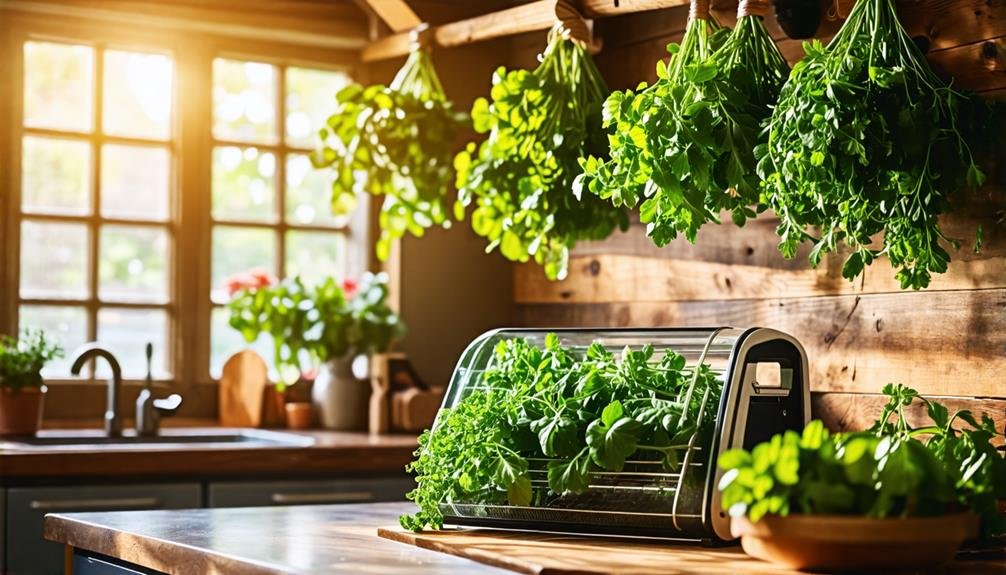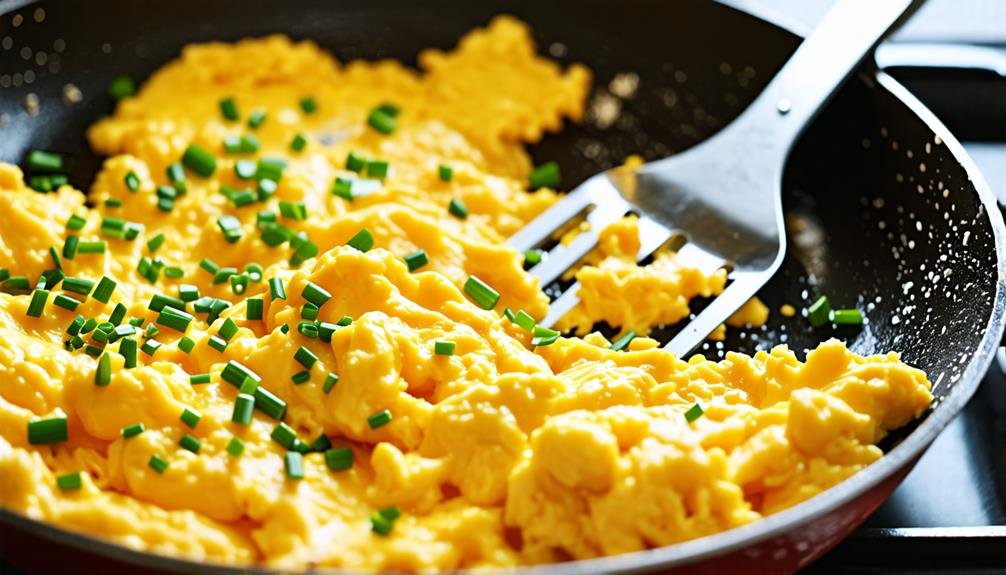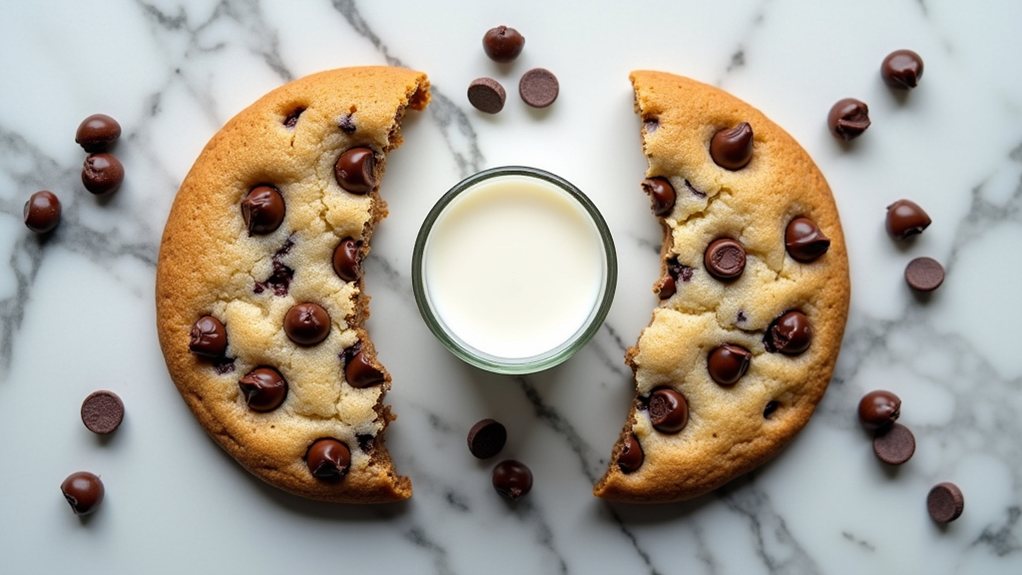Alton Brown's technique for perfectly drying herbs at home is both creative and efficient. He begins by immersing fresh herbs in boiling water for 15 moments, which preserves vivid colors and flavors. Following that, he moves them to an ice bath to stop the cooking process. During the drying stage, spread the herbs on air filters positioned in front of a box enthusiast. In approximately 12 hours, you'll have beautifully dried herbs ready for use. This method not only saves money but also elevates your dishes with hearty flavors. Explore more fascinating tips on preserving your culinary treasures!
Benefits of Drying Herbs at Home
Drying herbs at home offers a practical method to enhance your cooking while maintaining a consistent supply of vibrant, flavorful botanicals. As home cooking becomes increasingly popular, preserving herbs can elevate your dishes significantly. Picture using your own dried basil or oregano rather than opting for supermarket versions that often lack essential flavor.
One significant advantage of drying herbs at home is the control it offers over the quality of your botanicals. Culinary expert Alton Brown employs techniques that ensure freshness and robust flavor, making this method attractive to cooking aficionados. This practice not only saves money but also minimizes food waste, allowing you to utilize surplus herbs before they perish.
In addition, dried herbs are adaptable and can enhance various meals, including stews and marinades. Engaging in this kitchen practice deepens your relationship with cooking, helping you unlock the full potential of your ingredients. With a little practice, you can seamlessly integrate this skill into your culinary toolkit, enjoying the benefits of homemade flavor enhancements.
Alton Brown's Drying Technique
Alton Brown's drying technique utilizes a unique boiling method that helps herbs retain their bright colors and rich flavors during the drying process. This innovative approach starts by submerging fresh herbs in boiling water for a short 15 seconds. This quick immersion prevents oxidation, halting the browning that frequently occurs with conventional drying methods. Immediately afterward, the herbs are transferred to an ice bath, which helps maintain their vibrant hues and essential oils.
Next, the herbs are spread out on three stacked air filters, which promote optimal airflow. By securing these layers to a box fan with bungee cords, you create an efficient drying system. Running this setup for a minimum of 12 hours yields perfectly dried herbs, ready for your culinary adventures.
This method not only accelerates the drying process but also improves the quality of your essential kitchen ingredients. With Alton Brown's technique, you can enjoy the fresh, aromatic essence of herbs long after they reach their peak. Say goodbye to dull, wilted herbs and welcome a colorful array of flavors into your cooking. Embrace the joy of DIY herb drying and savor the fruits of your labor!
Alternative Drying Methods
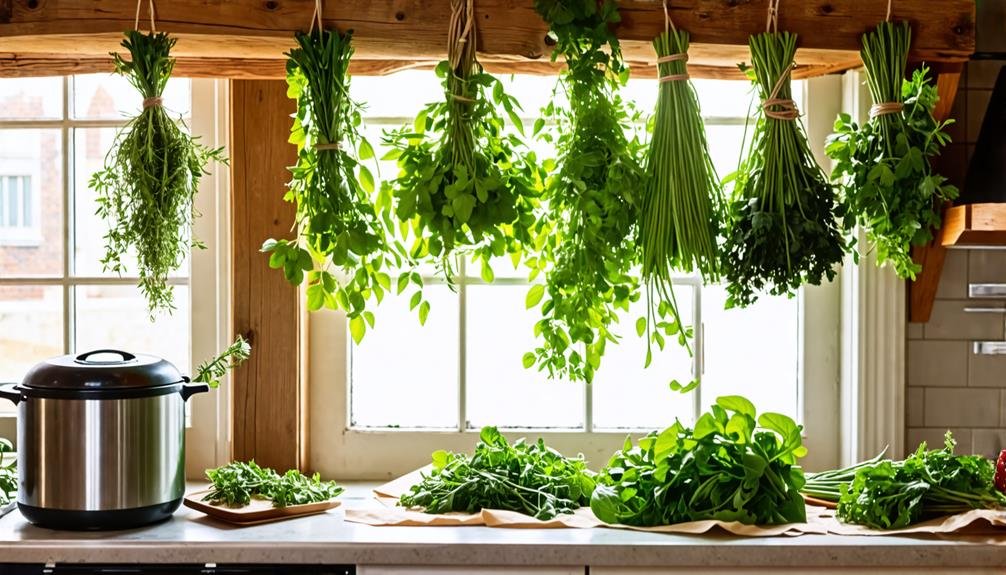
Various alternative methods exist for preserving culinary herbs, each offering distinct benefits for home chefs looking to expand their cooking skills. One classic approach involves suspending herb bundles in a dark, well-ventilated area. This traditional method, while reliable, often results in extended drying durations, sometimes taking several weeks to achieve optimal dryness.
For those eager to speed up the process, home dehydrators like the Excalibur offer an excellent solution. These devices utilize controlled heat and airflow to rapidly eliminate moisture, enabling you to enjoy flavorful herbs within a few hours. Microwaving herbs is another quick method; by applying short bursts of heat, you can dry them swiftly, although it requires careful monitoring to avoid over-drying.
Alton Brown's innovative technique, which utilizes a box fan and air filters, is notable for its efficiency and effectiveness. This method helps prevent undesirable browning while ensuring the herbs retain their vibrant flavors. Each approach has its unique appeal and effectiveness, so whether you favor the straightforward nature of air-drying or the precision of a dehydrator, the key lies in engaging with the process. Enjoy experimenting with these techniques to discover which best suits your herb-drying journey!
Importance of Proper Storage
Proper storage is essential for preserving the flavor and potency of dried herbs, ensuring they maintain their aromatic qualities for an extended time. After using Alton Brown's drying technique, the next step is to keep your herbs fresh. Store your dried herbs in airtight containers, which safeguard them from moisture, air, and light—three factors that can compromise their quality.
Select opaque glass jars or dark-colored containers to protect your herbs from light, as exposure can diminish flavor over time. Additionally, a cool, dark location is optimal for storage, allowing the herbs to retain their vibrant essence. Don't forget to label your containers with the herb name and the drying date, facilitating easy organization of your home herb collection.
Testing Herbs for Doneness
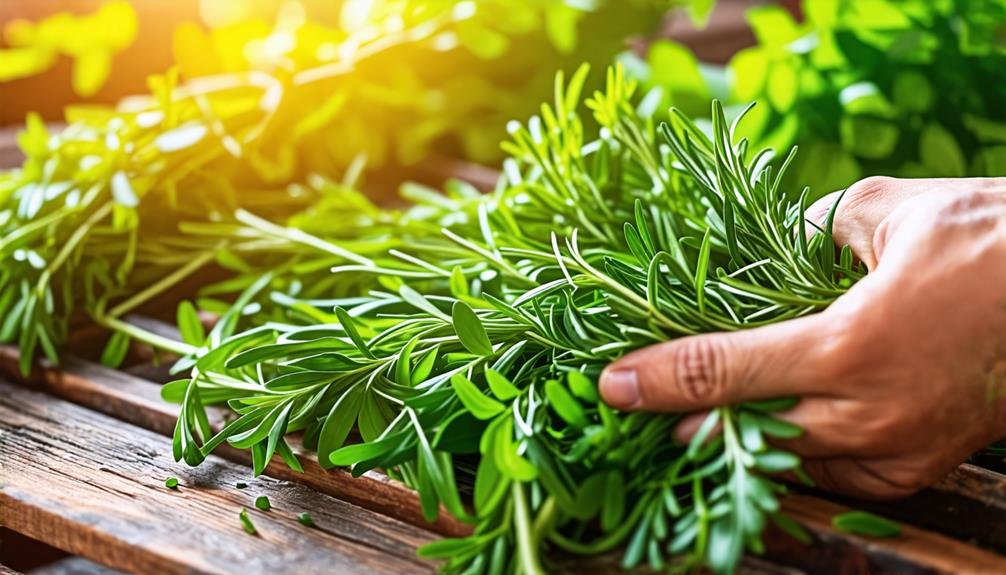
Testing dried herbs for doneness is essential to ensure they reach the perfect texture and flavor for cooking. The goal is to have herbs that are crispy and aromatic, ready to elevate your dishes. To check for doneness, take a few dried leaves and crush them between your fingers. If they break apart easily, they are likely dry enough. If they feel soft or damp, they need more time to dry.
Be cautious—dried herbs should not turn brown or become brittle; this signals over-drying, which can compromise their flavor. Pay attention to the aroma; it should be strong and reminiscent of fresh herbs. The desired texture is light and crisp, indicating that the essential oils and flavor compounds are preserved.
Once you confirm that your herbs are ready, store them in airtight containers to maintain their vibrant essence. With this simple assessment, you can ensure your dried herbs remain a delicious and essential part of your culinary repertoire, perfect for inspiring your next cooking adventure!
